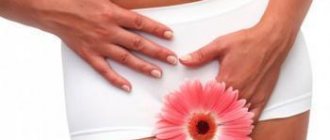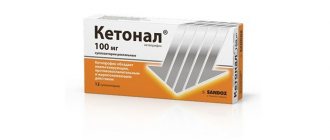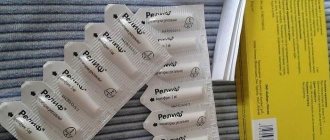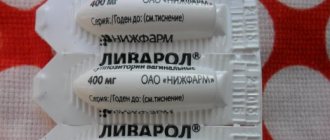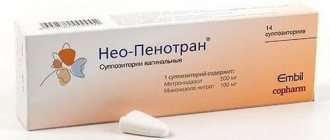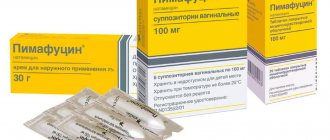Composition and release form
There are six known release forms of Panavir, intended for the treatment of various diseases . Their composition and packaging:
| Description | Compound | Package | |
| Solution for intravenous administration | Colorless liquid with a light brown tint | Water, sodium chloride | Ampoules of 5 ml, 2, 5 or 10 ampoules in a pack with instructions for use |
| Gel | Homogeneous white mass | Water, glycerol, macrogol, lanthanum nitrate hexahydrate, sodium hydroxide, ethanol | Aluminum tubes of 3, 5, 10 or 30 g |
| Rectal suppositories | White-yellowish candles in the form of a cylinder or cone | Solid or confectionery fat, emulsifier, paraffin | Polymer blister packs of 5 pcs., 1 or 2 packs in a pack |
| Vaginal suppositories for use in gynecology | Grayish-white translucent candles | Polyethylene oxide, macrogol | 5 pieces. packaged |
| Spray Intim and Inlight | Transparent gel-like mass | Eucalyptus oil, polyethylene glycol, castor oil, water, sodium hydroxide, lanthanum nitrate | Bottle with nozzle 40 ml |
| Toothpaste | White paste | Sodium fluoride, xylitol, sodium monofluorophosphate, calendula extract, D-panthenol, silver citrate | Tube 75 ml |
General characteristics and composition
This remedy, intended to eliminate the symptoms of viral diseases, is available in different forms. This allows you to choose the most suitable type of medicine: spray, suppositories, gel or injection solution.
Panavir, produced in the form of suppositories, can also be divided into two varieties: vaginal and rectal. They differ only in the method of application, but their composition is the same.
The main component is polysaccharides of plant origin (obtained from the Solanum tuberosum plant); one suppository contains 200 mcg.
In addition, the following ingredients have been added:
- confectionery fat;
- paraffin;
- emulsifier.
Suppositories are packaged in special blister packs in the amount of 5 pcs. They should be used only on the recommendation of a doctor, so as not to accidentally worsen your health.
Pharmacodynamics and pharmacokinetics
Panavir has immunomodulatory and antiviral effects; the product contains extract of potato tops shoots. The active substance of this extract is hexose glycoside (hexahydrate), consisting of rhamnose, mannose, galactose, glucose, arabinose, uronic acids and xylose. When treated with medication, the production of interferons is activated and nonspecific immunity increases.
The antiviral effect of the drug occurs due to the active substance inhibiting the synthesis of viral DNA in cells affected by it. Therapeutic doses of Panavir are well tolerated and do not exhibit mutagenic, allergenic, teratogenic, embryotoxic, or carcinogenic effects on the body. The drug has analgesic and anti-inflammatory activity, has a regenerative effect, accelerates the process of scarring of ulcers, has an antipyretic effect, and improves the functions of the optic nerve and retina.
pharmachologic effect
The effect of the drug is due to the characteristics of its composition. The interaction of plant components helps suppress the activity of the virus, which helps stop the further development of the disease.
The drug also increases the body's ability to resist infection. As a result, pathological symptoms are eliminated, and the provoking virus dies.
A very important feature of Panavir is its ability to stimulate the production of interferon, thereby achieving an immunostimulating effect.
Indications for use
Depending on the form of release, the indications for use of the drug differ. The instructions highlight the following:
- herpesvirus infections (herpes zoster, ophthalmic herpes, recurrent genital herpes);
- secondary state of immunodeficiency due to infectious diseases;
- cytomegalovirus infection (in the treatment of women with miscarriage, to prepare for conception during chronic viral infection);
- long-term non-scarring ulcers of the duodenum or stomach;
- papillomavirus infection;
- rheumatoid arthritis due to herpes;
- tick-borne encephalitis (as part of complex treatment);
- influenza, acute respiratory viral infections (ARVI);
- chronic bacterial prostatitis;
- skin diseases and infectious-inflammatory diseases of the mucous membranes.
Overdose
Pills
Panavir Inlight in tablet form is taken orally, preferably with meals.
Daily dose – 1 tablet. Course duration is up to 7 days. After 1–2 months, the dose can be repeated.
Panavir Inlight spray is applied to the surface of the mucous membranes of the mouth.
In order to reduce the risk of inflammatory diseases of the oral cavity, the procedure is carried out 2 times a day in the morning and evening. Single dose – 2-3 presses. The maximum effect develops with daily use.
If you have cold symptoms, the product can be used more often - up to 5 times a day.
Information is absent.
Panavir spray must be used according to official instructions or based on the recommendations of a specialist. Similar drugs used to treat the throat may have different indications for taking the medication. According to patient reviews, the medicine has a reasonable price.
The dosage is calculated according to the dosage form of the drug and the nature of the pathological process. The spray bottle must be shaken before use. When using, it is recommended to keep it in an upright position. If blockages form in the spray tube, it must be rinsed with water.
After use, the Panavir Inlight atomizer must be rinsed, preferably with alcohol, so that the hole does not become clogged!
For the prevention of influenza and acute respiratory diseases, 1-2 injections of the solution are prescribed 2 times a day after eating. When using the medication, you may develop a slight soreness or discomfort in the oral cavity and nasopharynx.
For inflammatory diseases of the oral cavity, treatment of the affected surface is carried out 2 times a day - in the morning and in the evening. Treatment with the drug is carried out over several days. For prophylaxis, the spray is used for 7 days. Before irrigating the spray, you must make sure that you are not allergic to the components.
Cases of drug overdose have not been registered. However, if the specified dose is exceeded, accompanied by the development of negative symptoms, it is necessary to stop taking the drug and consult a specialist. In case of spray poisoning, it is necessary to perform gastric lavage and carry out symptomatic therapy.
According to information from the manufacturer, even repeated and long-term use of Panavir is incapable of harming the human body, so there have never been cases of spray overdose. Also in the annotation for the drug it is noted that it is compatible with other drugs, for example, with antiviral drugs whose action is aimed at the influenza virus. The spray can also be prescribed and used together with antibacterial agents or non-steroidal anti-inflammatory drugs.
Directions for use and dosage
Instructions for use of Panavir differ depending on the release form. Thus, dental paste is used to cleanse the oral cavity for candidiasis or herpes. A small amount of it is applied to a toothbrush, after which the teeth are brushed in a circular motion with gentle massaging of the gums. The mouth is rinsed with a small amount of water. The procedure is repeated twice a day.
Solution
Panavir in ampoules, according to the instructions, can be administered intravenously slowly or in a stream. One ampoule contains 200 mcg of active ingredient, which is a therapeutic dose. For herpes and tick-borne encephalitis, the drug is used twice with an interval of 24-48 hours. Treatment is repeated after a month. Therapy for papilloma and cytomegalovirus infections involves using the medication three times with an interval of 48 hours during the first week and twice with a wait of 72 hours between injections in the second week.
In case of exacerbation of peptic ulcer, injections are given five times every other day, the course of treatment lasts 10 days. For rheumatoid arthritis, which occurs against the background of the development of herpes, 5 injections are given at intervals of 24-48 hours, the course is repeated after two months. For influenza and ARVI, doctors give 2 intravenous injections 18-24 hours apart. To eliminate exacerbation of chronic bacterial prostatitis, 5 intravenous injections are used with a period of 48 hours.
Panavir candles
Panavir suppositories are divided into rectal and vaginal. They should be used for their intended purpose. The instructions suggest that the first suppositories are inserted into the anus for prostatitis and for the treatment of children, vaginal suppositories are used by women to treat genital herpes. Depending on the form of release and purpose, the dosages of the drugs differ.
Rectal
Suppositories for rectal use are intended for the treatment of herpes virus infection and tick-borne encephalitis . For this, two candles are used with an interval of 24-48 hours. If necessary, a month later the treatment is repeated. According to the instructions, to eliminate signs of flu, use one suppository every 24 hours for a course of 5 days. For the treatment of cytomegalovirus infection and papillomas caused by the human papillomavirus, the use of one suppository three times (with an interval of 48 hours) in the first week and twice (with an interval of 72 hours) in the second is indicated.
Vaginal
Intravaginal suppositories (may be called tablets) are inserted deep into the vagina and are used by adult patients. They are inserted as deeply as possible, for convenience, bend your knees and lie on your back. Every day for five days one candle is used. Repeating treatment is possible after medical consultation. It is advisable to administer suppositories in the evening, before bedtime. Before use, wash the external genitalia and dry.
Gel Panavir
The gel form of the drug is mistakenly called Panavir ointment. According to the instructions, the gel is applied in a thin layer to the affected areas of the skin or mucous membranes up to five times a day. The course of treatment is up to five days; if necessary, the doctor extends it to 10 days. The gel can be applied to the affected vagina or urethra and is used at the first signs of the disease.
The use of the medication relieves itching, tingling, a feeling of tension, redness of the skin, and prevents the development of herpetic rashes. If you start using the product as early as possible, bubbles may not appear or may be found in minimal quantities. In 75% of cases, using the gel to treat rashes on the skin and mucous membranes leads to stable remission. The drug can be used to treat molluscum contagiosum, accelerate healing after cryodestruction, and laser coagulation.
Spray Panavir
According to the instructions, Panavir intimate spray is intended for treating the genitals. The second type of Inlight spray is used for application to the oral cavity. Before use, the bottle of product is shaken and held vertically. It is necessary to apply the medicine to the affected areas by pressing the valve 1-2 times. There is a special nozzle for intravaginal use.
After applying the gel, you can rub it in with light massaging movements or leave it to absorb on its own. A special nozzle allows you to administer the product intravaginally. If you use another nozzle, it can be inserted inside 2 cm, not deeper. To spray the spray in the mouth, place it on a flat surface, tilt the head to allow the nozzle to penetrate 1-2 cm into the mouth or nose, and press the valve 2-3 times. To prevent influenza, the spray is used twice a day.
Instructions for Panavir (rectal suppositories)
- home
- Instructions for Panavir (rectal suppositories)
< Return to previous page
Name: Panavir Release form: rectal suppositories Dosage: 200 mcg; INN: Potato shoot extract ATC code: J05AX Group: Antimicrobial drugs for systemic use Subgroup: Antiviral drugs for systemic use Pharmaceutical group: Direct-acting antiviral drugs Pharmaceutical subgroup: Other antiviral drugs
Characteristics: Dosage form and composition: Solution for intravenous administration: clear or slightly opalescent, colorless or light brown liquid, odorless. 1 amp. or 1 vial: - Panavir® (polysaccharides of Solanum tuberosum shoots) 200 mcg excipients: sodium chloride - 0.045 g; water for injection – up to 5 ml
Gel for external and local use: a homogeneous white mass with a slight specific odor. 100 g: - Panavir® (polysaccharides of Solanum tuberosum shoots) 0.002 g excipients: glycerol - 30 g; macrogol 4000 - 15 g; macrogol 400 - 38 g; ethanol 95% - 1 g; sodium hydroxide - 0.4 g; lanthanum nitrate hexahydrate - 2.2 g; water - up to 100 g
Rectal suppositories: white to white with a yellowish tint, cone-shaped or cylindrical in shape; The presence of yellowish-gray inclusions, odorless, is allowed. 1 supp.: - Panavir® (polysaccharides of Solanum tuberosum shoots) 200 mcg excipients: confectionery fat or solid fat - 1.0198 g; paraffin - 0.09 g; emulsifier T-2 - 0.09 g suppository weight - 1.2 g
Vaginal suppositories: cylindrical or cone-shaped, grayish-white, translucent. 1 supp.: - Panavir® (polysaccharides of Solanum tuberosum shoots) 200 mcg excipients: polyethylene oxide 1500 (macrogol 1500) - 1.2599 g; polyethylene oxide 400 (macrogol 400) - 0.1399 Pharmaceutical group: antiviral agent of plant origin. Pharmaceutical action: Panavir® is a purified extract of shoots of the Solanum tuberosum plant; The main active ingredient is a hexose glycoside, consisting of glucose, rhamnose, arabinose, mannose, xylose, galactose, and uronic acids. The drug Panavir® is an antiviral and immunomodulatory agent. Increases the body's nonspecific resistance to various infections and promotes the induction of alpha and gamma interferons by blood leukocytes. In therapeutic doses, the drug is well tolerated. Tests have shown the absence of mutagenic, teratogenic, carcinogenic, allergenic and embryotoxic effects. In preclinical studies on laboratory animals, no negative effects on reproductive function and fetal development were established. It has anti-inflammatory properties in experimental models of exudative edema, chronic proliferative inflammation and in the test of a pseudo-allergic inflammatory reaction to concanavalin A. An analgesic effect has been shown in models of neurogenic pain and pain caused by the inflammatory process and thermal irritation. Has an antipyretic effect. In a model of parkinsonian syndrome caused by systemic administration of the neurotoxin 1-methyl-4-phenyl-1,2,3,6-tetrahydropyridine, neuroprotective properties were shown. Has the ability to improve the functions of the retina and optic nerve. It has wound-healing properties in a gastric ulcer model. Pharmacokinetics: Solution for intravenous administration. When administered intravenously, polysaccharides are detected in the blood within 5 minutes after administration and are captured by the cells of the reticuloendothelial system of the liver and spleen. Elimination begins quickly; after 20–30 minutes, polysaccharides are found in the urine and exhaled air. Gel for external and local use, rectal suppositories, vaginal suppositories. The pharmacokinetics of these dosage forms of the drug have not been studied. Indications: Panavir solution for intravenous administration: - herpesvirus infections of various localizations, incl. recurrent genital herpes, herpes zoster and ophthalmic herpes; — secondary immunodeficiency states due to infectious diseases; - cytomegalovirus infection, incl. in patients with recurrent miscarriage. Can be used in women with chronic viral infection and interferon deficiency in preparation for pregnancy; — human papillomavirus infection (anogenital warts) — as part of complex therapy; - peptic ulcer of the stomach and duodenum in patients with long-term non-scarring ulcers and symptomatic ulcers of the gastroduodenal zone - as part of complex therapy; - tick-borne encephalitis - to reduce the viral load and relieve neurological symptoms (anisoreflexia, decreased reflexes, pain at the exit points of cranial nerves, nystagmus) - as part of complex therapy; - rheumatoid arthritis in combination with herpesvirus infection in immunocompromised patients (to enhance the analgesic and anti-inflammatory effect of the main therapy) - as part of complex therapy; — ARVI and influenza — as part of complex therapy; — chronic bacterial prostatitis — as part of complex therapy. Panavir gel for external and local use: - Infectious and inflammatory diseases of the skin and/or mucous membranes caused by the herpes simplex virus types I and II, incl. genital herpes. Panavir rectal suppositories: - herpesvirus infections of various localizations, incl. recurrent genital herpes, herpes zoster and ophthalmic herpes; — secondary immunodeficiency states due to infectious diseases; — cytomegalovirus infection, incl. in patients with recurrent miscarriage. Used in women with chronic viral infection and interferon deficiency in preparation for pregnancy; — human papillomavirus infection (anogenital warts) — as part of complex therapy; - tick-borne encephalitis - in order to reduce the viral load and relieve neurological symptoms (anisoreflexia, decreased reflexes, pain at the exit points of cranial nerves, nystagmus) - as part of complex therapy; — ARVI and influenza — as part of complex therapy. Panavir vaginal suppositories: - genital herpes in women - as part of complex therapy. Category of action on the fetus: - Solution for intravenous administration, gel for external and local use: Use during pregnancy is possible only when the expected benefit to the mother outweighs the potential risk to the fetus. If it is necessary to use the drug during lactation, breastfeeding should be stopped during the period of use of the drug. — Rectal suppositories: If it is necessary to use the drug during lactation, breastfeeding should be stopped while using the drug. Contraindications: Panavir solution for intravenous administration: - individual intolerance; - presence of allergies to the constituent components of the drug: glucose, mannose, rhamnose, arabinose, xylose; - lactation period; - children under 12 years of age. Panavir gel for external and local use: - individual intolerance and hypersensitivity to the components of the drug; - children under 18 years of age. Panavir rectal suppositories: - hypersensitivity; - pregnancy; - lactation period; - childhood. Panavir vaginal suppositories: - hypersensitivity to the components of the drug; - severe diseases of the kidneys and spleen; - pregnancy; - lactation period; - children under 18 years of age. Dosage: Panavir solution for intravenous administration: IV in a slow stream. The therapeutic dose of the drug is 200 mcg of active substance (contents of 1 amp. or 1 vial). For the treatment of herpes virus infections and tick-borne encephalitis, it is used twice with an interval of 48 or 24 hours. If necessary, the course of treatment can be repeated after 1 month. For the treatment of cytomegalovirus and papillomavirus infections, it is used three times during the first week with an interval of 48 hours and twice during the second week with an interval of 72 hours. For the treatment of gastric and duodenal ulcers in the acute phase and symptomatic ulcers of the gastroduodenal zone, 5 intravenous injections are used through day for 10 days. For the treatment of rheumatoid arthritis in combination with herpesvirus infection in immunocompromised patients, 5 IV injections are used with an interval of 24–48 hours; if necessary, the course can be repeated after 2 months. For the treatment of ARVI and influenza, 2 IV injections are used with an interval of 18–24 hours. For the treatment of patients with chronic bacterial prostatitis, 5 IV injections are used with an interval of 48 hours. Use in pediatrics: Panavir® is prescribed to children from 12 years of age at a dose of 100 mcg IV once a day. For the treatment of herpes virus infections and tick-borne encephalitis, it is used twice with an interval of 48 or 24 hours. If necessary, the course of treatment can be repeated after 1 month. For the treatment of cytomegalovirus and papillomavirus infections, apply three times during the first week with an interval of 48 hours and twice during the second week with an interval of 72 hours. Panavir gel for external and local use: Externally and locally. The gel is applied in a thin layer to the affected areas of the skin and/or mucous membranes 5 times a day. Duration of treatment is 4–5 days. The course of treatment can be extended up to 10 days. Panavir rectal suppositories: Rectal. For the treatment of herpes virus infections and tick-borne encephalitis, use 1 supp. twice with an interval of 48 or 24 hours. If necessary, the course of treatment can be repeated after 1 month. For the treatment of cytomegalovirus and human papillomavirus infections, 1 supp. three times during the first week with an interval of 48 hours and twice during the second week with an interval of 72 hours. For the treatment of ARVI and influenza, 1 supp. at 24 hour intervals for 5 days. Panavir vaginal suppositories: Intravaginal. Insert into the vagina in the evening, as deep as possible, in a supine position with slightly bent legs, 1 vag daily for 5 days. supp. A repeated course of treatment is possible after consulting a doctor. Side effects: - Panavir solution for intravenous administration, Panavir rectal suppositories: The drug is well tolerated, possible complications may be associated with individual intolerance and hypersensitivity to the components of the drug. — Panavir gel for external and local use: Rapid redness and itching of the skin and/or mucous membranes may appear at the site of application of the gel. — Panavir vaginal suppositories: In rare cases, allergic reactions are possible. If any unwanted side effects occur or if other side effects not listed in the instructions are noticed, you should stop administering the drug and consult your doctor. Overdose: No cases of overdose have been registered. The results of preclinical studies indicate low toxicity of the drug. Interaction: Not identified. Special instructions: Panavir solution for intravenous administration: when used in preparation for pregnancy, helps reduce the frequency of reproductive losses in cytomegalovirus and herpesvirus infections. If the solution becomes cloudy, the drug is considered unsuitable for use. Panavir gel for external and local use: it is recommended to start treatment at the earliest possible stage of the disease, at the first signs (itching, tingling, redness, feeling of tension), in this case the development of the vesicular stage of the disease can be completely prevented. Panavir® gel is not intended for use in ophthalmology. When applying the gel to the face, avoid getting it into the eyes. Panavir vaginal suppositories: to prevent urogenital reinfection, simultaneous treatment of sexual partners is necessary. If there is no effect, the diagnosis should be confirmed. Impact on the ability to drive a car or perform work that requires increased speed of physical and mental reactions. There is no data on the possibility of a negative effect of the drug on the ability to drive vehicles and carry out potentially hazardous activities that require special attention and speed of psychomotor reactions.
< Return to previous page
Panavir during pregnancy
Before using the product during pregnancy, you should consult your doctor. The solution and gel can be used when the benefit to the mother exceeds the risk to the child. During treatment with Panavir solution and rectal suppositories, breastfeeding is prohibited. When carrying a child, the instructions prohibit the use of rectal and vaginal suppositories, although no carcinogenic, mutagenic, embryotoxic or teratogenic effects of the drug have been identified. Sprays are allowed during pregnancy.
Indications and contraindications
Knowing the effect of a drug on the body allows you to understand whether the drug can be used for a particular disease. It is advisable that the patient still consult a doctor for this, but if this is not possible, you need to carefully study the instructions.
Panavir suppositories are recommended for use in the following situations:
- infection with human papillomavirus;
- viral encephalitis;
- cytomegalovirus infection;
- shingles;
- herpes;
- chickenpox;
- ARVI;
- flu;
- genital herpes;
- immunodeficiency.
This remedy is effective for both therapy and prevention. It can be used separately or in combination with other drugs.
It is necessary to know not only when to use this medicine, but also when its use is strictly prohibited. If the patient has contraindications, you need to choose another drug, since Panavir can lead to undesirable consequences.
Replacement of the drug is required in the following circumstances:
- sensitivity to the composition;
- bearing a child;
- breast-feeding;
- the patient's age is less than 18 years.
These contraindications apply to rectal suppositories. Panavir vaginal suppositories should not be used during pregnancy (especially the 2nd trimester) and breastfeeding, in childhood, or with diseases of the kidneys and spleen.
It is best to consult your doctor before starting treatment.
Panavir for children
Panavir solution can be used in the treatment of children over 12 years of age; for them, a dosage of half an ampoule or 100 mcg at a time is prescribed . Other dosage forms of the drug are well tolerated and have low toxicity, so in theory they can be used to treat children. Due to the lack of safety information, there is a limitation on this.
Suppositories for intravaginal administration are contraindicated in patients under 18 years of age; rectal suppositories are used to a limited extent for the treatment of influenza and rotavirus infection. The gel can be used in children of different ages to treat herpes. Inlite gel spray , also called children's spray, is used without restrictions. They treat the throat, mouth, nose and pharynx to speed up recovery and stop the course of a viral infection. The spray helps with a runny nose, viral tonsillitis, pharyngitis, and herpangina.
Operating principle
Polysaccharides in the spray are capable of:
- Prevent viruses from entering cells.
- Normalize the condition of the oropharyngeal mucosa, helping it recover faster from colds and other diseases.
- Suppress the formation of viral particles.
- Stimulate the local immune response.
- Reduce pain and local inflammatory response.
- Form a protective cover, soften and moisturize the mucous membrane.
We suggest you familiarize yourself with Trimedat or no spa
, which is better. The drug acts as an antiviral agent, affecting herpes viruses, rhinoviruses, molluscum contagiosum, influenza virus and other pathogens. The spray also has anti-inflammatory, antiseptic and bactericidal effects. In addition, Panavir has a healing and regenerating effect. The addition of eucalyptus oil enhances the antimicrobial, immunomodulatory and disinfecting effect of the spray.
Side effects of Panavir
The drug is well tolerated, so it is unlikely that adverse reactions will develop during its use. The instructions include the following possible consequences:
- increased sensitivity of the skin or mucous membranes;
- itching, redness of the skin;
- allergic reactions, urticaria, swelling, hyperemia;
- nausea, vomiting, dyspepsia;
- flatulence;
- headache, dizziness;
- vaginal discharge of unknown etiology.
Instructions for use
Before spraying Panavir onto the mucous membrane, it is important to make sure that the nozzle is tightly fixed to the bottle. Irrigation should be carried out from the bottom up - the child should tilt his head as shown in the picture on the paper annotation for the spray. The nozzle should be inserted shallowly into the oral cavity - up to 2 centimeters.
If the spray is prescribed for prophylactic purposes, then treatment of the oral cavity is recommended twice a day. The drug is sprayed in the mouth once in the morning and a second time in the evening, and for one procedure, 2-3 presses on the nozzle are used. To maximize the effect of using the gel, the product is used every day. If you have a cold or viral infection, you can use Panavir more often - up to five times a day.
For the youngest children, spray the spray on the inner surface of one cheek or apply it to a pacifier and let the baby suck on it. This treatment prevents the activation of the gag reflex. For older children, the medicine is applied to the mucous membrane of the mouth or throat, depending on the reason for using the spray.
Analogs
Drugs with antiviral and immunomodulatory effects can replace the drug . There are no analogues to Panavir in composition - this is a unique medicine. Drug substitutes are:
- Arbidol - antiviral capsules based on umifenovir.
- Yodantipyrine is an immunomodulatory tablet containing iodophenazone.
- Detoxopirol is an analgesic tablet containing natural plant extracts.
- Ferrovil is an immunomodulating solution based on a complex of sodium deoxyribonucleate with iron.
- Kagocel is an antiviral tablet based on the component of the same name.
- Lavomax - tablets containing tilorone, which stimulate the production of interferons.
- Oxoline is an antiviral ointment against influenza and herpes based on oxoline.
- Ergoferon – lozenges based on antibodies to interferon gamma.
- Ingavirin is an analogue of Panavir in the form of anti-inflammatory capsules containing pentanedioic acid imidazolylethanamide.
Indications
- Panavir Inlight gel is used to prevent and relieve symptoms of infectious and inflammatory diseases caused by viruses, bacteria and fungi.
- Prevention of infection and relief of symptoms of ARVI, influenza, viral rhinitis.
- Anti-inflammatory effect and improvement of regeneration in acute respiratory diseases.
- To improve the healing of injured oral mucosa after visiting the dental office, with bleeding gums.
- Prevention and relief of symptoms in infectious and inflammatory diseases of the external genital organs, accompanied by a decrease in local immunity and a disturbance in the composition of the microflora.
- Prevention of infection with viral and bacterial sexually transmitted diseases. As additional protection to traditional barrier products.
- Prevention of cervical cancer associated with oncogenic human papillomavirus infection.
- For symptoms of discomfort in the genital area, accompanied by itching, burning and dryness, including after sexual intercourse and with hormonal changes in the body.
- During the rehabilitation period after removal of papillomas and condylomas, including on the skin and mucous membranes of the genital organs.
Panavir price
You can buy the product in pharmacies or online. Approximate cost in Moscow:
| Type of drug release | Internet price tag, rubles | Pharmacy cost, rubles |
| Gel 3 g | 140 | 149 |
| Toothpaste 75 ml | 198 | 210 |
| Gel 30 g | 834 | 890 |
| Vaginal suppositories 200 mcg 5 pcs. | 1625 | 1700 |
| Ampoule solution 0.004% 5 ml 2 pcs. | 1633 | 1700 |
| Rectal suppositories 200 mcg 5 pcs. | 1698 | 1750 |
| Ampoules 5 ml 5 pcs. | 3748 | 3800 |
Can Panavir be used by children?
Many studies have been conducted that have shown that Panavir is generally well tolerated by children and does not cause adverse reactions. Despite this, not all doctors prescribe the described medication for children. However, most doctors agree that Panavir Inlight spray is effective in relieving the symptoms of viral infections. They resort to the help of remedies to get rid of a runny nose, acute respiratory viral infections, and inflammatory processes of the nasal mucous membranes.
If parents do not have the opportunity to buy Inlight, Intim is also suitable for children, since these medications have an identical composition.
Similar medications
Panavir spray is used as a therapeutic and prophylactic agent.
There are no medications that have the same composition as Panavir in pharmacy chains. However, there are a number of pharmaceuticals that have a similar mechanism of action on the body. Mostly medical professionals prescribe the following medications to patients:
- "Kagocel";
- "Lavomax";
- "Lirasept";
- "Nikavir";
- "Groprinosin";
- "Arbidol";
- "Amiksin";
- "Hyporamine";
- "Ingavirin";
- "Celsentry";
- "Tivikay."
It is important to note that Panavir contains an active herbal component, so the pharmaceutical product has virtually no contraindications and does not cause adverse reactions. The medications described above have completely different components, so they are more likely to cause side symptoms. If any illness occurs, it is important not to delay visiting a medical facility. Only the attending doctor will be able to prescribe the correct therapy and determine the duration of use of the medicine. Self-medication is fraught not only with not getting rid of the disease, but also with causing serious harm to your overall health.

